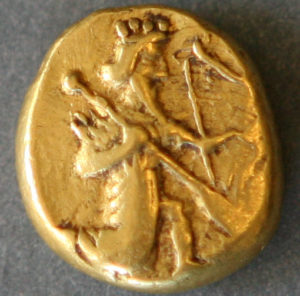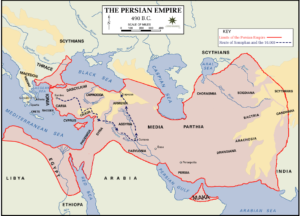This article discusses Persian Empire trade and economy / Trade in Persian Empire.
The early Persian economy was based on herding because the land was extremely poor for practicing agriculture. The Persians attributed their toughness to the meager lifestyle to which they had been acclimated for generations.

However, the sudden acquisition of the Median Empire, Lydia, Babylon, Egypt, and gold-rich areas in India made Persia an economic powerhouse. It controlled the rich agricultural areas of Mesopotamia, the grasslands of Anatolia, the trade routes in every direction, and rich deposits of metals and other resources.
Persian Empire Agriculture
Great King Darius instituted many economic innovations and reforms: systematized taxation; standardized weights, measures, and monetary units with the first successful widespread use of coins; improved transportation routes, including the 1600-mile Royal Road from Susa to Sardis and an early Suez Canal; royal trading ships; promotion of agriculture; a banking system; and promotion of international trade.
Persian Empire Government
The head of the Persian government was the king whose word was law. His authority was extended by a bureaucracy led by Persian nobles, scribes who kept the records, a treasury that collected taxes and funded building projects and armies, and a system of roads, couriers, and signal stations that facilitated mail and trade.
Much of the empire was divided into provinces called satrapies, ruled by a strap. All of Egypt was usually a single satrapy, for example. The satraps were normally Persians or Medes to help ensure their loyalty.

They ruled and lived like minor kings in their own palaces. Some satraps became strong enough to threaten the king. Strong kings kept their satraps in check by holding close the reins of the armies and the treasury.
Darius revolutionized the economy by placing it on a silver and gold coinage system. Trade was extensive, and under the Achaemenids, there was an efficient infrastructure that facilitated the exchange of commodities among the far reaches of the empire.
Persian Empire Trade Items
As a result of this commercial activity, Persian words for typical items of trade became prevalent throughout the Middle East and eventually also found an entry into the English language with examples like bazaar, shawl, sash, turquoise, tiara, orange, lemon, melon, peach, spinach, and asparagus being added into the glossary of words.
Trade was one of the empire’s main sources of revenue, along with agriculture and tribute. Darius also started use of a Royal Road that allowed messages, soldiers, and mail to be sent quickly across the empire. He promoted trade and business and established a law code.
Trade in Persian Empire
The Persian Empire would have a long life because of the efforts of Darius. The Persian Empire had a great impact on the region and its people. The Persians worked very hard in order to promote economic prosperity. Their roads, strong government, and stable coinage encouraged trade.

They also promoted agriculture with irrigation projects and the introduction of new crops to different areas, such as sesame to Egypt and rice to Mesopotamia. Of course, increased prosperity also generated more taxes.
The Persians also kept their subjects happy by charging moderate tax rates, about twenty percent of a person’s income. Despite this modest tax rate, the Persian kings were fabulously wealthy. By the time Alexander the Great took over the Persian Empire in 330 B.C.E., the Persian kings had reportedly amassed a treasury of 5500 tons of silver.